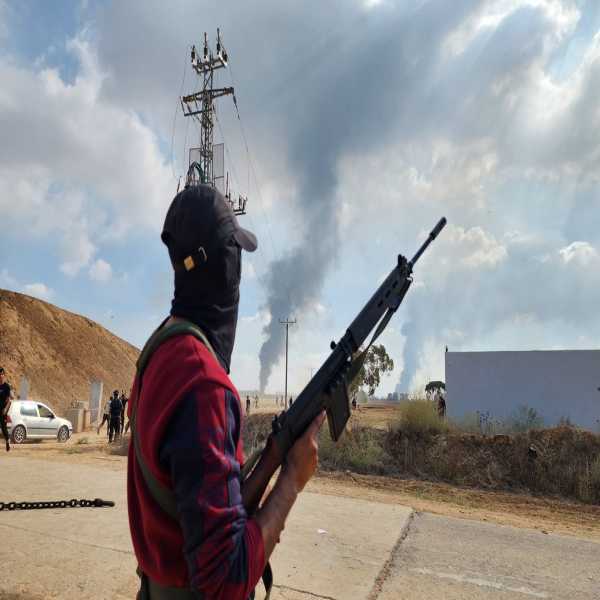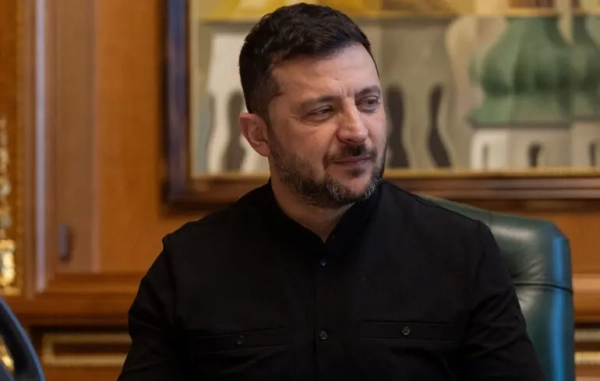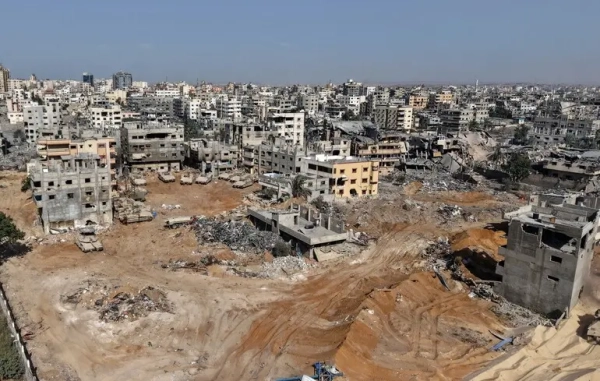The assault on southern Israel exposed the reality of the Palestinian conflict.

Palestinians took down the fence on the Israel-Gaza border and entered Israel on October 7. Hani Alshaer/Anadolu Agency via Getty Images Zack Beauchamp is a senior correspondent at Vox, where he covers ideology and challenges to democracy, both at home and abroad. Before coming to Vox in 2014, he edited TP Ideas, a section of Think Progress devoted to the ideas shaping our political world.
What’s happening right now in Israel almost defies imagination.
Overnight, Hamas fighters launched an unprecedented invasion across Israel’s southern border with Gaza, storming Israeli towns and killing Israeli soldiers and civilians alike. Thousands of rockets were fired into Israeli territory, and at least 100 Israelis are dead — a senior Knesset official said the attacks led to the most civilian deaths on a single day in the country’s entire history. The fighting in southern Israel is ongoing, with reports that Hamas is bringing Israeli hostages back to Gaza. Israel’s retaliatory airstrikes have already killed nearly 200 Palestinians, a figure that will likely only grow, as Israeli Prime Minister Benjamin Netanyahu said on Saturday that “our enemy will pay a price the type of which it has never known.”
Related
Hamas has launched an unprecedented strike on Israel. Here’s what you need to know.
Nothing like this has happened in the modern history of the Israeli-Palestinian conflict; even the bloody Second Intifada in the early 2000s never saw this kind of mass incursion into Israeli territory. Now an outright war between Israel and Hamas has begun, one whose consequences for the conflict and the broader Middle East we can only dimly anticipate. The only thing we can be certain about the future is that many, many people are about to die.
How can we begin to think about such a nightmare?
We can start by examining the conditions that made it possible. Though we can’t be sure why Hamas chose to launch this attack now, we do know that there are a number of background conditions — including not just the ongoing occupation but also recent surges of conflict in Jerusalem and the West Bank, a far-right Israeli government, and Israeli-Saudi negotiations about normalizing relations — that made the situation especially combustible.
And this leads to a second, more fundamental point: The conflict is not, as some have suggested, “stable” — and likely never can be made so.
So long as Israel rules over the Palestinian population, violence will be ongoing and escalation inevitable. The only real way to prevent this kind of thing from happening is for the two sides to come to a mutually agreeable solution that addresses the root causes of violence.
Except today, any solution seems further away than ever.
How Israel and Gaza came to the brink
In 2005, Israel unilaterally withdrew its troops and settlers from the Gaza Strip — a policy called “disengagement” that was designed, in theory, to remove Israel from direct management of the Palestinian-populated territory. But in 2007, following tensions with the official Palestinian leadership, the militant faction Hamas took control of the strip by force. Since then, things have been worse for Israelis and (especially) Palestinians.
Israel imposed a strict blockade on Gaza, tightly restricting the flow of goods and people in and out of the territory, entrenching the military occupation. Hamas tunneled under the border wall to launch cross-border raids and fired rockets into Israeli territory. Israel would periodically hit Gaza with airstrikes, often targeting operatives from Hamas and other militant groups — but inevitably hitting civilians in the crowded Gaza Strip.
The perennially tense situation escalated to outright war at least four times since disengagement prior to the current conflict. These previous conflicts were horrific for civilians (and, again, especially Palestinians), but never saw any kind of fighting on the scale of today on Israeli soil.
[Related: Benjamin Netanyahu failed Israel]
As combustible as this setup has been, Israeli leadership saw it as essentially the best arrangement available to them. They believed that they could reduce rocket fire to an acceptable level, relying on the Iron Dome missile defense system. Israeli troops and border security measures could prevent major cross-border raids.
Targeted killings and shows of force could deter Hamas itself from escalating too much, as they’d always bear the brunt of the suffering in a true war. These periodic strikes have been euphemistically termed “mowing the grass,” a reference to the idea that the terrorist threat couldn’t be eliminated but could be reduced to a tolerable level.
Today’s events showed that these assumptions were badly mistaken.
Hamas was not deterred from attacking Israel, nor was it stopped by border security. It penetrated Israeli territory through land, sea, and air; once its forces entered, they rampaged through southern Israel. The streets of Sderot, a border town, are currently a war zone.
The perpetual instability of the conflict
Why did everything go so horribly wrong? It’s too early to provide any definitive answers, but there are a few important factors to consider.
According to Hamas, the attack was provoked by recent events surrounding the Temple Mount, a site in Jerusalem holy to Jews and Muslims alike. In the past week, Israeli settlers have been entering the al-Aqsa Mosque atop the mount and praying, which Hamas termed “desecration” in a statement on their offensive (which they’ve named Operation Al-Aqsa Storm).
It’s implausible, to put it mildly, that Hamas was simply outraged by these events and is acting accordingly. This kind of complex operation had to be months in the making; the fact that it began one day after the 50-year anniversary of the Yom Kippur war, a surprise Arab invasion of Israel, is almost certainly not a coincidence.
But at the same time, Hamas’s choice of casus belli does tell us something important.
Palestinian politics is defined, in large part, by how its leadership responds to Israel’s continued occupation — both its physical presence in the West Bank and its economically devastating blockade of the Gaza Strip. Hamas’s strategy to outcompete its rivals, including the Fatah faction currently in charge of the West Bank, is to channel Palestinian rage at their suffering: to be the authentic voice of resistance to Israel and the occupation. The angrier Palestinians are at Israel, the greater Hamas’s political incentives for violence.
And the past few months have seen plenty of outrages, ones even more significant than events in Jerusalem. Israel’s current hard-right government, dominated by factions that oppose a peace agreement with the Palestinians, has been conducting a de facto annexation of the West Bank. It has turned a blind eye to settler violence against West Bank civilians, including a February rampage in the town of Huwara.
Israel’s focus on the West Bank may also have created an operational opportunity for Hamas. According to Uzi Ben Yitzhak, a retired Israeli general, the Israeli government has deployed most of the regular IDF forces to the West Bank to manage the situation there, leaving only a skeleton force at the Gaza border. The effort to secure permanent Israeli control over the West Bank, in this assessment, created conditions where a Hamas surprise attack could actually succeed.
There are also geopolitical concerns at work. Israel is currently in the midst of a US-brokered negotiation to normalize relations with Saudi Arabia, a major follow-up to the Abraham Accord agreements struck with several Arab countries during the Trump administration. Normalization is widely seen among Palestinians as the Arab world giving up on them, agreeing to treat Israel like a normal country even as the occupation deepens.
Hamas could well be trying to torpedo the Saudi deal and even trying to undo the existing Abraham Accords. Indeed, a Hamas spokesperson said that the attack was “a message” to Arab countries, calling on them to cut ties with Israel.
[Related: This Gaza war didn’t come out of nowhere]
Rising tension in Jerusalem and the West Bank, weaker border security, an Arab political situation turning more and more unfavorable to the Palestinians — these are all conditions in which it makes more strategic sense for Hamas to take a such a huge risk.
To be clear: Saying it makes strategic sense for Hamas to engage in atrocities is not to justify their killing civilians. There is a difference between explanation and justification: The reasoning behind Hamas’s attack may be explicable even as it is morally indefensible.
We’ll find out more in the coming weeks and months about which, if any, of these conditions proved decisive in Hamas’s calculus. But they’re the necessary background context to even try to begin making sense of today’s horrific events.
It is impossible to say, at this point, where this situation is heading. Fighting in southern Israel is ongoing; the Israeli counteroffensive in Gaza has yet to truly get underway. It’s possible that the fighting pulls in other forces, like Hezbollah in Lebanon; there’s some speculation that they were involved in the attack. This can, and almost certainly will, get much worse.
But what’s clear at this point is that the situation cannot ever be truly stable.
The very nature of the current situation, in which Israel rules over the Palestinian population, creates powerful incentives for radical groups like Hamas to engage in brutal acts of terrorism. Both Hamas and Israel’s current government are ideologically inclined toward violence rather than peace, conflict rather than cooperation. Without some kind of radical political change, there’s no real solution on the horizon.
Meanwhile, it’s clear who is suffering the greatest consequences: not the extremist leaders on either side, but ordinary Israelis and Palestinians alike.
Sourse: vox.com






